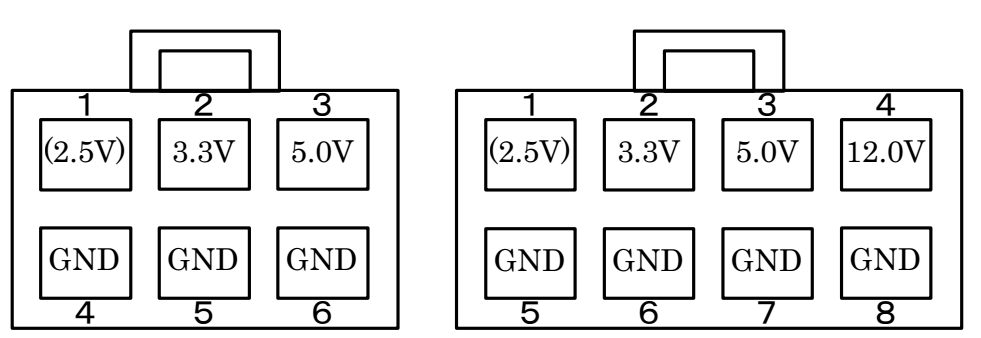Power delivery
JVS and JAMMA have slightly different approaches when it comes to power delivery:
| Rail | JVS | JAMMA | Jammafier |
| -5V | n/a | YES – 2 wires | Generated on-board |
| 3.3V | YES – 2 wires | n/a | Used by Jammafier |
| 5V | YES – 2 wires | YES – 4 wires | Passive delivery, monitored |
| 12V | YES – 1 wire | YES – 2 wires | Passive delivery, monitored |
The Jammafier takes 5V and 12V from your cabinet and delivers it passively. In addition, it has an on-board DC-DC inverter that generates the -5V needed for some games.
The Jammafier itself only consumes 3.3V, and will not interfere with 5V delivery.
You need to connect both connectors for the Jammafier to operate properly, and ensure good power delivery to your game.
Warning
DO NOT connect a Jamma game to the Jammafier before verifying your cabinet delivers correct power. You can do this by connecting the Jammafier to your cabinet with no game, and verify the voltages on the on-screen voltmeter.
If the voltages shown on the Jammafier varies a lot between games, it is an indication that the power cables in your cabinet are not thick enough. With proper cabling, it should not be necessary to adjust the voltage on your PSU when changing games.
Details on power for the technically inclined
To ensure good power to your game, there are basically 2 things that needs to be in place:
- A good power supply that can supply stable voltage for power hungry games (high current)
- Minimal resistance between supply and game
JVS Power

These are the JST-VL connectors and pin-outs specified in the JVS Standard, image is looking at the game. Although it has a lot of wires, only 5V is of interest when it comes to Jamma games. Naomi Unversal cabinets use 18AWG wires, so effectively 1x15AWG is available for power delivery.
What is voltage drop?
If you measure the voltage coming out of your power supply, you may get a different reading than if you measure the actual game. This is called voltage drop, is caused by the wires used, and the formula is basically just Ohm’s law:
Vdrop = IR,
where I is the current your game use and R is resistance of the wires between game and power supply, including return GND wires.
You can’t do much about the current consumption of the game, so the only variable left is the resistance of the wires. Resistance in wires is affected by:
- Material
- Width
- Length
Thin long wires have higher resistance than short thick ones – and in general you want to try to have them as short and thick as possible. Using wires in parallel to decrease resistance works well, and is used by both old Jamma and JVS. For every doubling of wires, subtract 3 from the AWG number:
- 2xAWG24 is the same as 1xAWG21.
- 4xAWG24 is the same as 1xAWG18 (2xAWG24=1xAWG21, 2xAWG21=1xAWG18)
- 2xAWG18 is the same as 1xAWG15.
Incidentally, (not really☺), AWG15 has half the resistance of AWG18. This leads to a couple of rule-of-thumbs:
- 2 x current (power usage) = 2 x voltage drop
- Half the resistance = half the voltage drop
This is a real issue – the game Salamander uses 4.1A, while Cave SH-1 only uses 0.5A. In the same cabinet, the Salamander game will have EIGHT times the voltage drop of the Cave game.
Namco issues
The Namco JVS2JAMMA has 3 main issues when it comes to power delivery.
- Jamma harness cabling
- PCB layout
- PCB current draw
The wire harness on the Namco uses 4*24AWG cables for 5V, which equals a single 18AWG wire. Although it is pretty short, combined with the PCB layout and the fact that the PCB itself uses 0.5A, it all adds up to it being problematic with power hungry games.
Konami issues
While the Konami does a lot of things right, it was one major fault:
- Single power connector
This effectively means only one wire is used for 5V, and in the case of Naomi Universal – it will be a single 18AWG. The Konami does not generate -5V, but it has a header that is routed to the Jamma connector – so it is possible to feed it via a “Negatron” or similar device.
Riverservice/RS issues
No -5V, and no header – soldering required if you need it.
Last Updated on 2022-09-14 by admin
